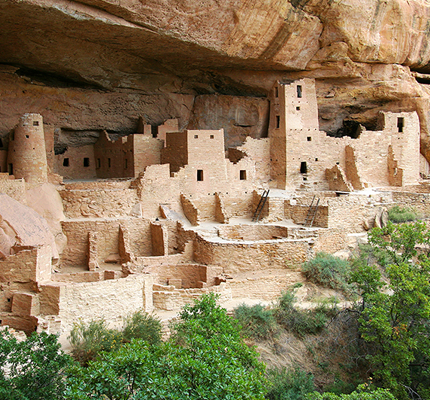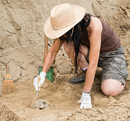
There are conscientious individuals who seek to decolonize the management of Indigenous heritage places in the United States. These activists, scholars, and professionals already have changed key practices within cultural resource management. For example, the National Park Service (NPS) now consults representatives of affiliated tribes, nations, and pueblos in some of its management decisions. The NPS recruits members of descendant communities to work at Indigenous heritage places (though its recruitment efforts have not been particularly successful). Modern federal policies, such as the Native American Graves Protection and Repatriation Act of 1990, have restored many important cultural items to their communities of origin.
Both the NPS and the federal government have put effort into correcting some of the government’s past misdeeds in the context of Indigenous heritage management. However, for all that there are earnest individuals who want to return control of Indigenous heritage to members of descendant communities, there are many hurdles that stand in the way. Three that I will discuss here are the historical circumstances that resulted in the federal stewardship of American Indian heritage places, the structuring policies that dictate who controls Indigenous heritage, and the powerful cultural attachments that members of the dominant settler culture have to archaeology and Indigeneity in the American West.
The legacies of settler colonialism are undeniable in the context of cultural heritage management in the United States. The distinguishing feature of settler societies is the fact that colonizing forces—-usually people from Europe—-choose to stay and establish permanent settlements within the territories that they colonize. Through violence, aggressive policies, and appropriative rhetoric, members of settler societies assert control over peoples, lands, and resources. Indigenous heritage places are among the resources that settler societies claim as their own. Though it may not seem obvious to people who enjoy visiting Indigenous heritage places in the United States, there are many ways in which members of the settler culture today continue to assert control over Indigenous heritage, repeating rhetorical patterns that white social actors established in the 19th century.
Historical Circumstances
 I approach the problem of settler stewardship over Indigenous heritage places from a very particular perspective. I am a European American, a Coloradoan, and a former archaeologist. I study how white preservation advocates attempted to turn Ancestral Puebloan heritage places into national parks and monuments at the turn of the 20th century. Though my research deals primarily with harmful attitudes in the past, it is clear to me that dominant cultural attachments to Indigenous heritage places continue to reflect the beliefs of the individuals who first established national parks and monuments in the Southwestern United States. While my research has a regional and historical focus, it has implications for the federal stewardship of Indigenous heritage more generally, as well as for the subtle ways in which settler ideologies continue to permeate many public practices.
I approach the problem of settler stewardship over Indigenous heritage places from a very particular perspective. I am a European American, a Coloradoan, and a former archaeologist. I study how white preservation advocates attempted to turn Ancestral Puebloan heritage places into national parks and monuments at the turn of the 20th century. Though my research deals primarily with harmful attitudes in the past, it is clear to me that dominant cultural attachments to Indigenous heritage places continue to reflect the beliefs of the individuals who first established national parks and monuments in the Southwestern United States. While my research has a regional and historical focus, it has implications for the federal stewardship of Indigenous heritage more generally, as well as for the subtle ways in which settler ideologies continue to permeate many public practices.
There is one Indigenous heritage place in the Southwestern United States whose history of appropriation through advocacy serves as a helpful illustration of the points I make here: Mesa Verde National Park. Mesa Verde is a large landscape, with several settlements built by a group of people now known as the Ancestral Puebloans. The Ancestral Puebloans lived throughout the Four Corners region (Arizona, Colorado, New Mexico, and Utah). Many of the sandstone structures built by the Ancestral Puebloan people remain standing, though their architects largely moved away by 1300 CE or so. The descendants of the Ancestral Puebloans continue to live in the Southwest. The NPS website for Mesa Verde National Park notes that the landscape has at least 26 associated tribes, pueblos, and nations, including the Hopi Tribe and the following pueblos: Zuni, Acoma, Laguna, Zia, Santa Ana, San Felipe, Santo Domingo, Cochiti, Taos, Picuris, Sandia, Isleta, Santa Clara, Ohkay Owingeh, San Ildefonso, Nambé, Tesuque, and Pojoaque. The boundaries of Mesa Verde National Park interface with lands belonging to the Ute Mountain Ute Tribe, the Southern Ute Indian Tribe, and the Navajo Nation. Mesa Verde fits into the ongoing, contemporary lives of vibrant American Indian communities and holds a unique place in each community’s history.
Mesa Verde also fits into a very particular history of preservation advocacy, antimodern romanticism, and scientific research in late-19th century settler culture. Mesa Verde came to the attention of the settler public through the U.S. Geological Survey of the 1870s, through presentations at expositions by white geologists and adventurers, and through the press. Newspaper accounts detailed the stories of ranchers in Colorado who followed lost cattle into a large, unoccupied pueblo that they later dubbed “Cliff Palace'' and turned into a tourism destination. Stories about Mesa Verde spoke of the heroism of the white people who dared to explore it, the beautiful desolation of its “ruins,” and the mysterious disappearance of the people who had originally built their homes there. As we know today, there was no mysterious disappearance. The Mesa Verdeans just moved away—probably to Arizona. Yet, the settler public preferred the more scintillating versions of events. Many of the European American people who wrote about Mesa Verde in the 19th century expressed a sense of wonder about its sandstone structures and its departed builders. Yet, that fondness for Indigenous cultural heritage from the past coexisted with condescension and violence toward American Indian contemporaries.
The historical record demonstrates that racism frequently accompanied the primitivism and fascination that white stakeholders expressed in their evaluations of Mesa Verde. Troublingly, though not surprisingly, much of the racism that white travelers, geologists, ethnologists, and archaeologists displayed toward their American Indian contemporaries appeared in the context of scientific racism. Members of settler culture felt that the archaeological evidence at places like Mesa Verde would unravel the mysteries of cultural evolution, a now-debunked anthropological theory that categorized members of different races and ethnicities according to their apparent levels of technological and intellectual development. Cultural evolution supported racial hierarchies and racist attitudes. In the United States, white members of the settler culture used the supposedly scientific tenets of cultural evolution to justify the mistreatment of communities of color. While Mesa Verde might have inspired fantasies about Indigeneity in members of the settler public, research at that site also encouraged the very real disenfranchisement of living American Indian communities. Westward expansion actively endangered living Indigenous communities. At the same time, a growing coalition of heritage preservationists began to lay claim to historical Indigenous sites as part of United States patrimony.
Structuring Policies
Mesa Verde’s establishment as a national park in 1906 was the result of decades of collaboration among politicians, researchers, and a women’s organization called the Colorado Cliff Dwellings Association. Mesa Verde National Park is the first national park that the United States established for the protection of cultural, rather than natural, preservation. Congress approved the park’s establishment the same month that it passed the Antiquities Act. Both gestures were sensitive to growing concerns among white geologists, ethnologists, and archaeologists, who feared that amateur collecting and vandalism at historic Indigenous sites would disrupt their scientific research. There were other justifications for setting aside Ancestral Puebloan structures, such as the enjoyment or edification of the public. However, the scientific rationale reigned supreme.
Though historic Indigenous sites in the American Southwest had been set aside by the federal government as early as 1892, the Antiquities Act of 1906 fundamentally changed the nature of heritage management in the United States. Most importantly for the context of this essay, the Antiquities Act concretized the prominent role of science and of formally recognized research institutions in the evaluation of Indigenous heritage sites. According to the Antiquities Act, the U.S. president may use an executive order to set aside lands in the federal domain as long as they contain “objects of historic or scientific interest.” The Antiquities Act allows for “the examination of ruins, the excavation of archaeological sites, and the gathering of objects of antiquity” by reputable research institutions, in the interest of “increasing . . . knowledge.” Thanks, in part, to the phrasing of the act, and of course because of persistent cultural norms, the scientific rationale remains an integral aspect of heritage management throughout the United States. Though other policy changes have influenced cultural resource management in the United States substantially, the Antiquities Act is the reason that more than a dozen Ancestral Puebloan landscapes became national monuments in the first place. Its influence on heritage management in the Southwestern United States persists.
Enduring Cultural Attachments
One consequence of settler culture’s attachment to the scientific value of Indigenous heritage places is that those places continue to be defined primarily as archaeological sites. It is an observable fact that archaeological research has taken place at many Ancestral Puebloan cultural landscapes. However, the label of “archaeological site” activates the settler public imaginary, and subtly evokes both the supremacy of science and the mystique of antimodern romanticism.
Western culture finds archaeology quite alluring, thanks in no small part to representations of archaeology in such popular culture texts as Agatha Christie novels and Indiana Jones films. The archeologist Cornelius Holtorf identifies numerous sources of “archaeo-appeal” in his book, From Stonehenge to Las Vegas: Archaeology as Popular Culture. Holtorf observes that public infatuation with archaeological sites comes from many sources. For some, interest tends to focus on the superlative aspects of those places, such as their size or their age. People enjoy hearing about how researchers used small pieces of evidence to compile an image of how life was for the original occupants of an old structure. Archaeological sites also help people perform identity work at multiple levels. A person’s professional reputation may be tied to what they do at such a place. A family road trip might include a tour of an antiquity, forging fond (or terrible) memories. An individual might relate to a place as part of their personal heritage, as part of their national identity, or as part of a reflection on what it means to be human. Finally, the affective experience of being at an archaeological site may serve as a powerful source of “archaeo-appeal.” Holtorf points out that, while the narrative of scientific discovery is among the sources of attraction for visitors to archaeological sites, there are also personal, experiential enchantments that are at work.
There are critical differences between Holtorf’s research context and the realities of tourism and research at Mesa Verde. Holtorf learned about the aforementioned sources of “archaeo-appeal” by surveying tourists at Bronze Age and Neolithic archaeological sites in Germany. The “archaeo-appeal” that members of settler culture perceive in places like Mesa Verde differs necessarily from the fascination available in a place that is not situated in a settler society. The history of colonization in the United States always tinges settler engagement with Indigenous heritage. It is for this reason that we must attend so carefully to the enduring rhetorical appropriations of Mesa Verde and other Indigenous heritage places. Offhand remarks about technological development, cultural strangeness, and phenomenal wonder, made by members of settler culture at Indigenous heritage places, revive the same harmful patterns of thought that justified settler colonialism in the first place.
Thinking Differently
As a thought experiment about the very specific way that Ancestral Puebloan heritage places fit into the settler public imaginary, consider a comparison between two sites—Notre-Dame de Paris and Cliff Palace in Mesa Verde National Park. These two sites have quite a lot in common. Both sites are part of UNESCO’s World Heritage listings, as smaller portions of broad cultural landscapes that include evidence of trade, domestic life, and religious life. Indeed, both places include explicitly sacred spaces that were venues for cultural rituals. Both were under construction during the 12th and 13th centuries and required significant technological skill and innovation. The laborers who built both places probably could not read. Artisans at both places decorated the buildings that they left behind. Both places have been sites of archaeological research, and archaeological research is on display at both sites. Both are meaningful to people from many different cultural groups. When either site suffers damage, advocates come forward and mourn it as a loss to the world’s heritage.
This thought experiment is not intended to show all of the ways that Cliff Palace and Notre-Dame are the same, but rather to problematize how the public imaginary paints them so differently in spite of their similarities. The most notable difference may be the fact that one is widely considered a world masterpiece and the other an object of scientific fascination. One shows off the history of a colonial power, and the other shows the deep history of the colonized. Mesa Verde, its architects, and their descendants are still subject to the strange hierarchies and fantasies that European American social actors imposed on them in the 19th century.
It might be tempting to imagine that racism, primitivism, and fetishization at Indigenous heritage places are old problems. From the comfort of the present, it is easy to scoff at the behaviors of historical figures who were caught in the mindset of a bygone age. However, members of settler culture remain caught by cultural attachments pertaining to nature and the sublime, to antimodern romanticism, and to cultural evolution. Whether intending to or not, members of the United States settler culture continue to rhetorically re-colonize Indigenous heritage places.
My opinion that members of settler culture re-colonize Indigenous heritage places is sure to be unpopular in some circles. After all, many of the people who claim to love national parks the most—who proselytize to others about how magnificent protected landscapes are—are the ones who unwittingly reinscribe those spaces as part of the settler domain. The United States settler culture prioritizes science, recreation, patriotism, and property, and these values tend to eclipse Indigenous sovereignty, Indigenous histories, and the wishes of many contemporary American Indian stakeholders in the context of federally managed Indigenous heritage places. My task here is not to provide a single, correct way of interpreting Indigenous heritage places that are under settler care. It cannot be done, and it is not my place to attempt it. Rather, my goal is to urge members of settler culture to reimagine how they might engage with Indigenous heritage places, and to reject the appropriative values that settler culture writes on those landscapes.
ABOUT THE AUTHOR

LUCY BURGCHARDT is Assistant Professor of Communication Studies at Augustana College. Burgchardt spent two archaeological field seasons with Proyecto Cerro Mejía in southern Peru and holds an M.Phil. in Archaeology from the University of Cambridge. Burgchardt’s background in archaeology informed her doctoral research in Communication at the University of North Carolina at Chapel Hill. Her dissertation, “Attitudes Toward Antiquities: Rhetorical Enchantments, Preservation Advocacy, and the American Southwest” (Carole Blair, advisor) won NCA’s Gerald R. Miller Outstanding Doctoral Dissertation Award in 2019.

